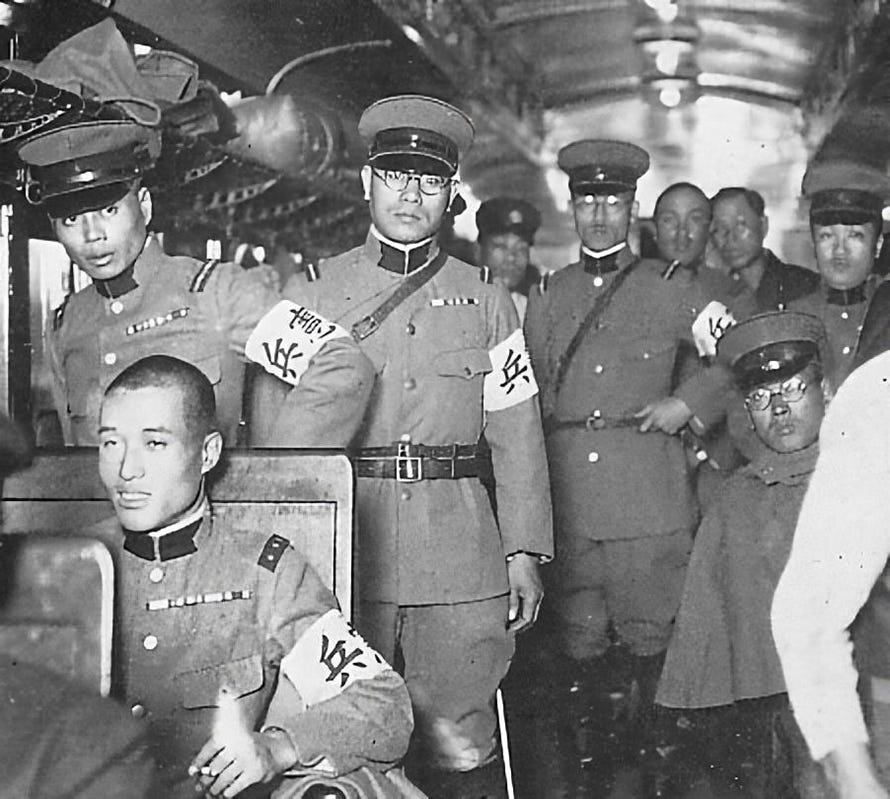The fortunes of the Kim family in Shanghai changed when Japan’s Kempeitai arrested Peter Kim and took him to their torture chamber in the Bridge House in early October 1943. Japanese intelligence identified Peter, a native speaker of American English, as potentially a useful asset for propaganda radio broadcasts. He would have been a replacement for a White U.S. citizen named Don Chisolm who had collaborated with Japan as a radio announcer in Shanghai—a male version of Tokyo Rose—since February 1942 but had since fallen out of favor.
Peter endured 10 days of interrogation and torture in the Bridge House by kempeitai agents who tried, but failed, to break him into agreeing to become a collaborator.

Shaken by the experience, Peter resigned from his work for the Swiss Consul on behalf of interned Americans that had brought him to the attention of Japanese intelligence. As he recovered, his thoughts turned to the idea of escaping Shanghai. Leaving the city and journeying far inland to free China, where the Nationalist Chinese army was holding out with the support of U.S. airpower, might give him a chance to volunteer for the U.S. armed forces and join the fight against the Empire of Japan.
More than 1,000 kilometers separated Shanghai from the frontline city of Changsha, where Chinese forces had stopped the Japanese invasion from moving further inland since 1939. Reaching Changsha would require traveling on the Japanese-controlled railroads and on riverboats that would have to run a gauntlet of checkpoints manned by Japanese soldiers and the Japanese-controlled Chinese puppet army. The journey would be long and dangerous, requiring the assistance of Chinese smugglers who knew the routes and could take travelers along them without arousing suspicion along the way.
Leaving Shanghai became even more urgently necessary as Japan began conscripting Koreans into its army on a massive scale in 1944. With Japan running out of military manpower after seven years of war, drafting Koreans was one way to replenish the gaps in its army’s ranks. By 1945, the Imperial Japanese Army in China alone had more than 100,000 Koreans filling out its units. With Richard approaching 17 years of age and at risk of being drafted and forced to fight for the enemy, Peter and his mother decided that the time had come to leave Shanghai with Richard.
Peter joined a group of Chinese civilians, led by a friend of Ruth Moy named Peter Chang, who had made arrangements to leave Shanghai in May 1944. The day before their departure, Peter visited the Swiss Consulate to say goodbye to Emile Fontanel and was showered with support and advice: money to cover the expenses of the journey, a promise by Fontanel to look after Peter’s family during his absence, and moreover, a tip from another Swiss consular official to look for a specific U.S. official in Chongqing who might be willing to help him, since Peter had fought to add his son-in-law to the list for the second Gripsholm exchange voyage in September 1943.
On May 10, 1944, Peter and Richard had their last meal in Shanghai at Jimmy’s Kitchen, a restaurant that they had been going to since the 1930s, whose owner Jimmy James was in the Chapei internment camp. In the evening, they said farewell to the family and set off for the railway station and the start of their journey to an uncertain future.
This series previews my upcoming book Victory in Shanghai: A Korean American Family’s Journey to the CIA and the Army Special Forces, whose publication is expected by June 1, 2025. You can pre-order it now through Potomac Books, an imprint of the University of Nebraska Press, at this link, or through your favorite local independent bookseller.
Subscription to this series is free.
If you know anyone who may be interested in this series, please share it with them.





